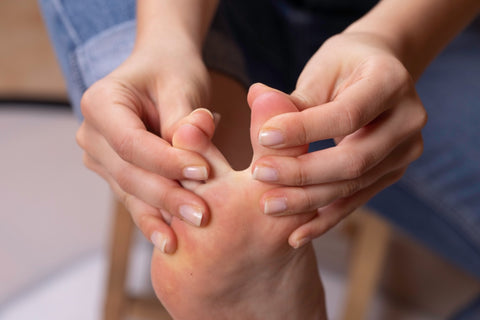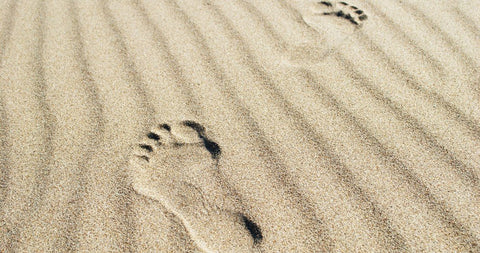
Foot Hygiene & The Importance of Clean Feet
Can poor hygiene cause infections like athlete’s foot?
Athlete’s foot normally affects those who don’t keep their feet clean and dry or are often walking barefoot in public areas such as gyms, shared showers and changing rooms.1 Although poor hygiene is not the only cause of athlete’s foot, not caring for your feet can make problems worse. If you don’t dry your feet properly, the warm and damp area between your toes creates the perfect breeding ground for the fungus to grow and allows it to infect a larger area quickly. If you have the infection, you’ll notice sore, itchy skin between your toes that is red and flaky, and covered in small blisters.1
How to beat athlete’s foot
Athlete’s foot is highly infectious so can spread quickly. However, there are a few things you can do to reduce the risk of passing on the infection. Always wash your hands after contact with your feet. Wear clean socks made from breathable materials like cotton, and don’t share shoes with anyone. If you are at the gym or pool, make sure you don’t share towels, and always wear flip flops or sandals in communal areas to prevent the infection spreading.2
Athlete’s foot can be treated at home using products such as the Scholl Pen and Spray. This kit allows you to treat the infected skin with the pen, whilst also providing a prevention spray to help cleanse your shoes to prevent reinfection of the fungus. Make sure you clean around the affected area before applying your treatment and continue using even when the rash has gone, to ensure the fungus has definitely been removed.
What causes smelly feet?
Smelly feet are not only unpleasant for you, but they can also cause embarrassment. Although everybody’s feet sweat, the sweat itself is not the cause of the common smelly foot. The smell forms when the bacteria on the skin starts to break down the sweat as it comes through the pores, creating a ‘stinky’ or even cheesy odour.2 Although sweating is something, we all do, some people naturally sweat more than others. There are also more sweat glands on your feet than any other part of the body, so it’s understandable why they get sweaty so quickly.1-3
How to prevent smelly feet
If you want to prevent smelly feet, there are a few simple steps you can take. It is important to only wear shoes that are fully dry and not wear the same pair day after day. Feet can become smelly if sweat soaks into the shoes and you then wear them again before they have time to dry. If you are prone to hot, sweaty feet make sure you give your shoes at least 24 hours to dry naturally before wearing them again.1-3
Wash your feet every day to remove built up bacteria and dirt, then dry them properly to remove any left-over moisture. You should also ensure that you change your socks daily. 1-3
You can improve your foot health and smelly feet by using sprays that will help to reduce the amount of sweating. This could be specialised foot deodorant and antiperspirant or simply the one you would normally use on your armpits. 1-3
Will bad hygiene cause warts and verrucae?
Warts and verrucae are extremely common, especially with children and teenagers. Most of us will experience them in our lifetime or will know someone who has had one. Warts and verrucae are an infection caused by 100 different strains of the Human Papillomavirus (HPV).4,5 This common virus creates an excess amount of a hard protein called keratin, which then develops in the top layer of the skin and creates the wart or verruca shape. Verrucae are only found on the sole of the foot and are usually flat compared to warts, which are raised from the skin.4,5
Foot hygiene isn’t the direct cause of warts and verrucae, but with care you can avoid them spreading further. Wash your hands after you have touched the infected area, cover warts and verrucae where possible and regularly change your socks. The virus that causes warts can easily spread through direct or indirect contact, for example a simple handshake or using the same towel. Verrucae are more easily spread on the surface of wet communal areas such as swimming pools.4,5
Can warts and verrucae be removed?
Although warts and verrucae can disappear on their own, you can remove them yourself using a Scholl DIY home wart and verruca removal kit.4,5 This treatment is based on the liquid nitrogen freezing method that is used in hospitals. It quickly freezes the wart or verruca, and after 10-14 days, the wart or verruca will fall off and there will be new skin underneath. 4,5 The infected area may need multiple treatments depending on the size and shape of the wart or verruca. 4,5
A guide to fungal nail infections
A fungal nail is one of the most common foot infections. That doesn’t make it any more pleasant to have. It’s caused by a fungus that thrives in warm, dark and damp areas and is extremely contagious. The infection begins as an overgrowth of fungi in, on or under the nail which can come in two main forms; Distal Subungual Onychomycosis (DSO) or White Superficial Onychomycosis (WSO).6,7
DSO is the most common type, which infects the skin under the nail bed. This can make the nail turn a yellowish-brown colour, becoming weak and brittle. It may even crumble away from the toe. WSO affects the top layer of the nail. You’ll notice white chalky patches appearing, but the nail will not crumble. 6,7
How to treat and prevent fungal nail infections
More than one in five people are embarrassed by their fungal nail and feel so self-conscious that they refuse to walk barefoot in their own homes. 6,7 Luckily, fungal nail infections can be easily treated at home without going to your GP. Scholl Fungal Nail Treatment is an easy to use two-step process, with a file to roughen the nail so the medicated liquid can get deep into the nail bed to treat the infection at the source. 6,7
The best way to prevent a fungal nail infection is to regularly check your toes for any early signs such as discolouration or peeling nails. 6,7 Wear well fitted, comfortable shoes that allow your feet to breathe, and take the time to properly dry your feet after a shower or swim. This will help to keep your feet healthy and prevent infection. As fungal nail is so infectious, avoid communal areas like pools or the gym until the infection has completely cleared. 6,7
To prevent foot problems, it’s important to add foot care into your daily routine. Look after your feet and make sure you regularly check them for the early signs of any infections. Healthy feet can fight off infections better than unhealthy feet and will look more attractive all year round. 6,7
